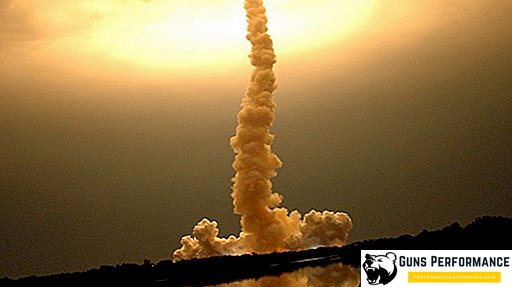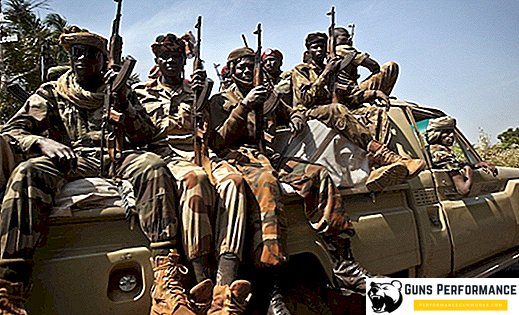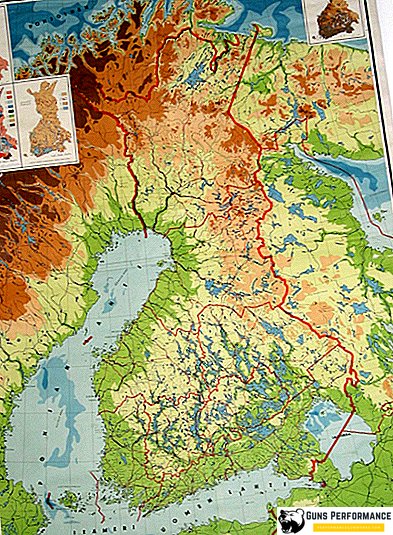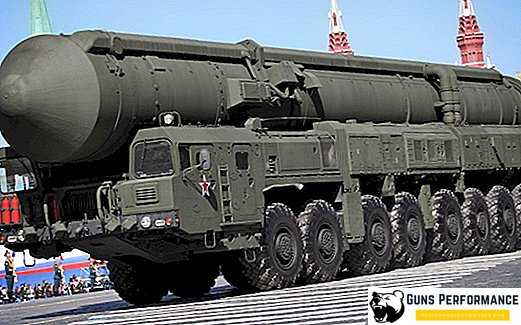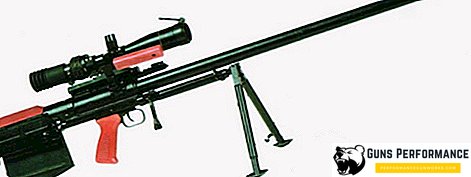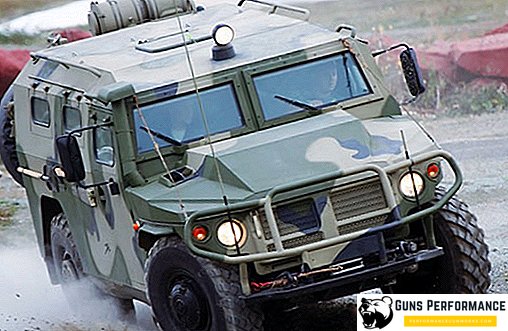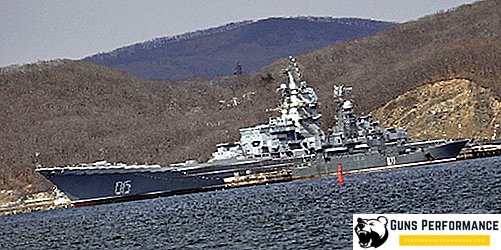
The nuclear-powered missile cruiser, tail number 015, the Admiral Lazarev, belongs to the four of the largest surface warships of the Project 1144, built in Soviet shipyards. The ships of this project were built at the Baltic Shipyard in Leningrad and were to mark with their appearance the domination of the Soviet Navy in the oceans. Neither before nor after the ships of this class of this size were built in the domestic fleet or abroad. In terms of their power and displacement, these Soviet ships are the last largest ships in the Soviet Navy. Missile cruisers with a nuclear power plant opened a new page in the history of modern fleets - the era of new atomic battleships.
The concept of a missile cruiser in the Soviet version
Nuclear cruisers, on which the Supreme Naval Command of the USSR was counting, were to become the most powerful strike surface ships at sea, not counting aircraft carriers. With a displacement of 25 thousand tons and with a hull length of 250 m - these steel monsters were to be carried along the ocean smooth surface at a speed of 31 knots. Huge firepower and dimensionless autonomy of navigation made these ships truly masters of the seas. No wonder the Americans attributed the Soviet nuclear-powered ships to the class of "battle cruisers". In the Soviet Navy - Project 1144 ships belonged to the class of heavy nuclear missile cruisers (TARKR). By the name of the lead ship of the TARKR Kirov series, the ship received the designation "Kirov-class battlecruiser" in the NATO classification.
The crew of this colossus was 750 people, and the power supply was provided by a nuclear installation of 150 thousand horsepower. The power of one reactor installed on Soviet cruisers was enough to provide electricity for the whole city.

The appearance in the structure of the US Navy of the Long Beach, a nuclear-powered cruiser with an atomic power plant, caught the Soviet fleet by surprise. At that time, by the beginning of the 60s, the old cruisers of Project 68-bis were part of the Soviet Navy, carrying artillery weapons and missile cruisers of Project 58. The former performed a representative role and added only a quantitative aspect to the Soviet fleet. The latter could fight the enemy’s surface ships in a limited maritime theater. The main emphasis in the construction of surface ships in those days was made on the creation of anti-submarine and anti-mine ships, destroyers and BOD. Military ships of the Project 1134 can be considered full-fledged missile cruisers, however, they remained in the BPC class.
It can be said that the launching of a surface ship with a nuclear power plant overseas served as the impetus for the beginning of designing a new class of strike ships in the USSR. The new ships, having received powerful anti-ship missile weapons and a nuclear reactor at the stage of development of the technical specifications, were transferred to the class of cruisers. The Soviet fleet entered an era of rapid development and therefore was in dire need of ocean-class ships capable of operating at a great distance from their bases. In 1964, scientific research and technical work began on the creation of a new nuclear-powered project. Initially, the tactical and technical tasks involved the construction of a ship that was identical in displacement to an American Long Beach type URO cruiser. Later it was decided to make changes in the future project, focusing on the creation of a ship of superior firepower.
The birth of the project
The atomic cruiser, based on the design stages, should have been larger and more powerful than the American cruiser. The main criterion on which Soviet designers relied in the development of the project was considered sufficient combat stability. The ship was supposed to have the means to fight at sea and weapons capable of repelling air strikes. The future cruiser was supposed to have a layered defense, providing protection for all the most important combat units and sections of the ship.

Initially, difficulties arose with the desire to fit a powerful anti-ship weapon, anti-submarine weapons and an advanced air defense system in one building. There were theories about the creation of two ships that were supposed to act as a pair. One combat unit served as a strike ship. Another combat unit provided anti-submarine cover. The air defense systems of the two ships operating in the pair could provide defensive defense across all horizons. The final decision won in favor of the fact that the nuclear cruiser should be a universal ship in which shock functions would be equally combined and there were means for anti-submarine warfare.
The ever-growing demands for the combat support of the future ship and its technical capabilities led to a dramatic increase in the armament range of the ship. Significantly increased the amount of equipment. The ship is noticeably added in displacement. Design displacement parameters of 8000 tons left far behind. In the end, the contours of a universal multi-purpose ship with a nuclear power plant began to emerge. The displacement of the ship in the design version was, neither more nor less, 25 thousand tons. The warship at this stage was already different from all the existing warships. In 1972, the Northern Design Bureau completed the project, which received the code 1144. It was planned to build five ships of this class. The ships were called "Orlan" and were laid as Atomic Anti-Submarine Ships. However, already in the process of building the lead ship, it became clear that the ship went far beyond the anti-submarine ship. The naval command was forced to create a new class of ships under the new project - a heavy nuclear missile cruiser.
Construction of cruisers with nuclear power plant

The lead ship of the series, called the Kirov, was laid in the spring of 1973. The construction of the nuclear-powered icebreaker lasted less than four years. Only in 1977 the ship was launched. The second ship of the nuclear-powered cruiser Frunze series was laid in 1978, during the period when the lead ship was still equipped with machines and mechanisms. The first ship TARKR "Kirov" entered service of the Northern Fleet in 1980. The second nuclear cruiser was built for the Pacific Fleet. The ceremonial launch was held on May 26, 1981. Until the summer of 1983, the ship had a head-mounted power plant, the main components and assemblies of the life support of the ship. The new nuclear-powered ship was ready to receive the crew, which was previously formed on the basis of the 10th squadron of the Pacific Fleet. After commissioning in the summer of 1985, the ship made a transition from Severomorsk to Vladivostok with a length of 2,692 miles, rounding Europe, Africa and Asia. During a long transition on the ship, the propulsion system was tested in all modes and firing of all types of ship armament was carried out.
The nuclear-powered missile cruiser Frunze, now the cruiser project 1144 Admiral Lazarev, became the pride of the Pacific Fleet of the USSR. The ship received its new name in 1992 in honor of the famous Russian naval commander Mikhail Petrovich Lazarev.
Still in the process of completion, the ship received a number of improvements over the design of the first-born of the TARKR "Kirov" series. The new warship of the Pacific Fleet, having appeared in the Far East, immediately changed the balance of forces. Having a high autonomy and seaworthiness, the powerful ship was able to take control of the vast waters of the Pacific Ocean, from Kamchatka to the South China Sea.
Design features TARKR "Admiral Lazarev"
In general, the design of the second ship of the series was identical to the design of the head cruiser, but when the head ship was still on the slipway, the project was supplemented, receiving a new index of 11442. The main changes were made to the defensive complex. Old combat systems and systems were replaced with new models. The cruiser received the latest Dagger anti-aircraft missile system. Instead of turret installations of six-barreled automatons, guns ZAK "Dirk" were installed on the vessel.

Anti-submarine armament TARKR "Admiral Lazarev" led to a more perfect look, instead of the anti-submarine complex "Metel" on the ship installed a new complex "Waterfall". Anti-submarine defense reinforced rocket bombers RBU-6000. The nuclear-powered ship received a reinforced ship artillery. Instead of two AK-100 turret guns, the AK-130 twin artillery was installed on the cruiser.
Having a large technological resource on armaments, not all Soviet nuclear cruisers could receive the same armament. Each subsequent ship, even on the improved project 11442, was equipped individually.
The second and third ships of the series, the nuclear cruiser Kalinin, now Admiral Nakhimov, had an intermediate composition of weapons, in comparison with the first ship of the series and with the last TARKR Peter the Great.
On the cruiser "Admiral Lazarev" the fodder batteries of 30-mm machine guns were removed to the superstructure area. A helicopter platform was installed in their place, along the perimeter of which they installed the Dagger air defense system. Since the cruiser served the least of his fellows, the modernization did not affect him. The newest Dagger anti-aircraft missile systems did not appear on it. Changes from the main and anti-aircraft artillery affected the stern of the ship and the superstructure, however, the bow of the ship has undergone some changes. Instead of launchers of the Metel complex, compact standard torpedo tubes of the Waterfall complex, designed for torpedoes, were installed on the ship.
Radar equipment on the cruiser has also undergone changes compared with the lead ship. On the equipment of the TARKR "Admiral Lazarev" they installed the MPK MP-800 Flag, which consisted of two radar stations MP-600 and MP-700, Voskhod and Fregat, respectively. The cruiser was armed with a logging system "Lumberjack-44" and MKRTS "Coral-BN".
The history of the service of the cruiser "Admiral Lazarev"
After the launch of the nuclear-powered missile cruiser Frunze, the current TARKR Admiral Lazarev, did not have a flag. The raising of the flag on the ship was timed to the anniversary, to the 100th anniversary of the birth of M.V. Frunze, which accounted for February 2, 1985.
In the spring of 1985, the ship went out to sea, where rockets were launched from the main strike anti-ship complex Granit. The shooter's permanent home registry was the Strelok Bay on the outer raid of Petra Bay near Vladivostok. The main combat service of the ship began in 1986, when the ship first went on a military campaign. The ship’s area of responsibility included the Pacific Ocean east of the Kuril and Japanese islands. The main objective of the campaign was to follow the routes of the carrier groups of the 7th US fleet. The atomic missile cruiser in this campaign closely interacted with other ships of the Pacific Fleet, the aircraft-carrying cruiser Novorossiysk and the large anti-submarine ship Tashkent.
During 1987 and the following 1988, the ship carried out regular launches of the Granit anti-ship missiles during combat trips. During the active service of the nuclear cruiser Frunze passed more than 65 thousand nautical miles. The collapse of the Soviet Union found the most powerful ship of the Pacific Fleet at the naval base in Strelka Bay. By the order of the Minister of Defense of the Russian Federation, in the spring of 1992 the ship received a new name - the heavy nuclear missile cruiser Admiral Lazarev - and a new crew number.
From this moment on, the active combat life of the vessel ceased. Due to the lack of funding in the mid-90s, the ship remained at the quay wall, losing its unique characteristics and combat capabilities. Unclear situation with the ship was delayed for 8 years. Only in 1999 it was decided to withdraw the combat unit from the Pacific Fleet to the combat reserve, assigning the 2nd category to the ship. The result of these decisions was the conservation of the ship. With the weapon removed, the immobilized cruiser was left at its pier in the village of Fokino.
The condition in which the ship is today
The ship, which has been idle for many years at the quay wall, today represents a sad sight. The news, leaking to the press about the state of the missile cruiser, is extremely contradictory. TARKR "Admiral Lazarev" at the moment has lost its combat capability. All major life support and armament systems on a ship are disabled or stolen. Against the background of general chaos, the traces of a fire that broke out on the ship on December 6, 2002 are clearly visible in the interior. The fire blazed for four hours, affecting not only the residential decks, but also sneaked into the command post. They extinguished the fire for four hours.

Immediately after the fire, it was decided to remove from the ship the remnants of nuclear fuel remaining in the reactor core. Practical work on the unloading of nuclear fuel was started at the Zvezda Shipyard only in 2004. The process lasted for a whole year, after which the remaining weapons were dismantled on the ship. The next ten years, nothing was heard about the ship. In 2014, news came that the former missile cruiser is going to dock. Together with the dock inspection, the ship underwent the same dock repair during which the state of the ship hull was established. Finally, it was decided to upgrade the ship with its subsequent commissioning.
The shipbuilding capacity in the Far East was clearly not enough to fully carry out a comprehensive modernization of a warship of a class like the Admiral Lazarev TARKR. To start repairs now, the cruiser needs to be transferred to the Northern Fleet along the Northern Sea Route. The old and battered cruiser is unable to withstand such a long and difficult transition on its own. It was decided to wait for the situation when the two largest dry docks will be put into operation at the Zvezda shipyard.
Future of the Orlan 1144 nuclear cruisers
To date, they have adopted a large-scale state program for the modernization and restoration of nuclear cruisers of the Orlan type project 11442. At present, the last of the four ships of this project, the TARKR Peter the Great, is in service.
On the agenda is the restoration and modernization of nuclear-powered cruisers "Admiral Nakhimov" and "Admiral Lazarev". According to experts, the technological resource of the ship design has not completely exhausted itself. In the plans of the Supreme Naval leadership is not provided to build new ships of this class. However, to restore the old nuclear-powered ships and breathe new life into them, the task is quite feasible. It is planned to have in the fleet three ships of this class: two cruisers in the Northern Fleet and one in the Pacific Ocean. All work on the modernization of ships is planned for 5 years. The launch of the upgraded nuclear cruisers is scheduled for 2020. Projects are one thing, implementation is another matter.
According to the latest data today, repairs are being made only at the TARKR Admiral Nakhimov. Modernization affected all major components and assemblies of the vessel. Changing the ship and weapons. Instead of launchers for PKR "Granit", the ship is equipped with launch containers for PKR P-800 "Onyx" (export version of PKR "Granit").
With his older brother, with the cruiser "Admiral Lazarev", the situation for the better does not change. Repair work on the ship has not yet begun. Probably, the ship will go to recycling. Two existing cruisers after modernization will form the backbone of the surface forces of the Joint Strategic Command in the Arctic region.
Eventually

The nuclear-powered missile cruiser Admiral Lazarev firmly took its place in the history of the Soviet and Russian navy. This ship, like all its fellow project 1144, had a short and beautiful combat life. Ships appeared too late. Historical changes affecting the country's economy did not spare the steel monsters. Created in the times of the Soviet Union, missile cruisers continue to be the largest strike surface ships of the Russian fleet. After the launch of the last ship of the TARKR "Peter the Great" series at Russian shipyards, ships of this size and of this class were no longer built.
It should be noted that nuclear-powered missile cruisers were the most expensive ships, first in the Soviet fleet, and later in the Russian. According to their combat characteristics, nuclear-powered submarines were inferior to the nuclear submarines of projects 949 and 949A. In addition, nuclear submarines were much cheaper than nuclear cruisers. You can compare the combat effectiveness of a surface ship with a submarine, but surface ships are holders of the flag of the state at sea, so the time to discount the value of large surface ships has not yet come.



